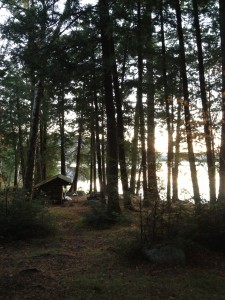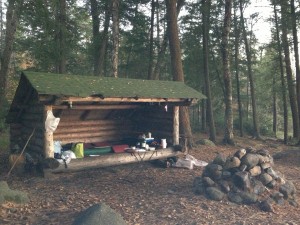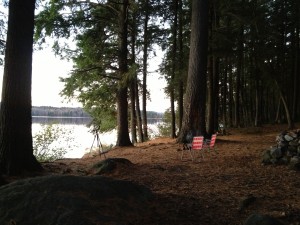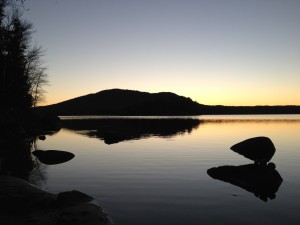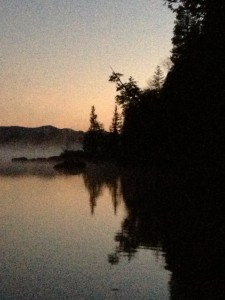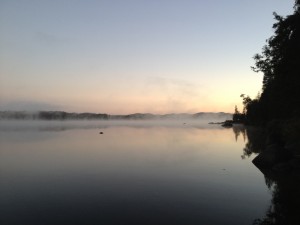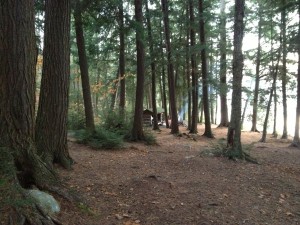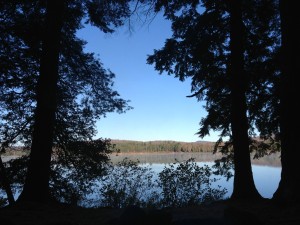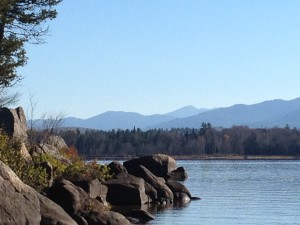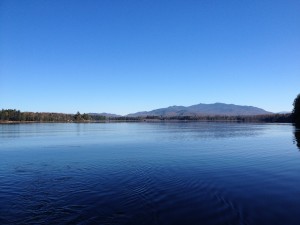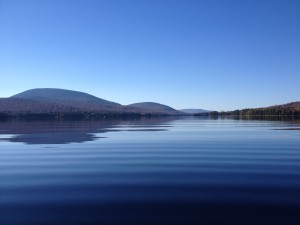Climate Change
A Night Out in the Adirondack Wilderness
On Friday, October 11, 2013, my husband George and I camped at the “Island House” lean-to along the remote, north-end of 14-mile Long Lake (this lean-to has views across the lake of an island of the same name). We motored over 8 miles from our beach to this spectacular location about ¾ of a mile from the north end of the lake. This end of Long Lake is surrounded by Adirondack wilderness, with mostly boat-access-only camps, and lovely views of the High Peaks. In spring and fall, you can often have this end of the lake completely to yourself. It feels like paradise!
As we slowly motored north in our pontoon boat, a young Bald Eagle was also heading north and it flew parallel to our boat over the shoreline. Common Loons were numerous and molting into their duller winter plumage. Female Common Mergansers were diving for food. We passed Round Island, Camp Islands, Pancake Islands, and Island House before pulling up to our camp location. The lean-to was hidden up on a knoll of mature White Pine, Hemlock, and Birch trees.
As we pulled up to the shoreline, I noticed an Osprey perched about 75 feet away on a dead snag over the water. It was drenched from fishing. The bird took flight and actively fished for several minutes, dragging its feet and body across the lake in continuous, futile dive attempts to catch fish.
The sun was beginning to set, so we quickly set up the lean-to with our camping gear. As the light faded away, a Bald Eagle began to vocalize on the island across from our camp. This is the same island where Bald Eagles now nest each year. I found it interesting that they were still roosting at the nest location in October. Nearly dark now, a shorebird silhouette quickly flew along the shoreline.
George built a fire. The sky was clear and it was going to be a cold night.
Memories…
**********
I began to think about all the places I’ve camped around Long Lake in over a decade and a half. This location was the 12th different place, with well over 40 different camping trips across all four seasons. Some of the trips were at lean-to locations or designated tent areas, but many were bushwhack trips to wetlands or mountain summits along the lake. Many of the trips were with our two sons and their friends as they grew up. There were many humorous moments…
One time we camped in a lean-to location and found a large group of Girl Scouts in a nearby lean-to that sang non-stop until 1 a.m.!
Another time, I took my two sons and two Golden Retrievers to a lean-to location where a couple thru-hiking the 136-mile Northville-Placid Trail (which runs along Long Lake) showed up and used their tent so we could have the lean-to. Just as we were all heading to bed, the young man said, “Hey, one of my boots is missing”! Anyone who has spent time with Golden Retrievers knows exactly what happened! We all searched for hours with headlamps, and I finally offered to boat to town in the morning and buy the man a new pair of hiking boots (he still had 36 miles of wilderness to hike through). I imagined that my dog Max had dumped his boot in the lake! But by some miracle, Max got up at 3 a.m. and ran off into the woods, and returned with the missing boot! Phew!
On a solo camp trip to the very north end of the lake at Turtle Beach, I arrived at sunset to find a family of 3 (plus their son’s friend) with 3 large tents (one for the parents, one for the boys, and one for their toys…lots of toys!), furniture (tables, chairs, etc.), and enough lamps and lights that the place was lit up like a church. I stood speechless wondering how they fit it all in their boat. It felt as if they had brought suburbia to the wilderness! The next morning, as the family slept, I had coffee while watching an actively hunting Mink at the edge of the water!
During one of my difficult trips bushwhacking up Kempshall Mountain for the annual June Mountain Birdwatch survey, I found an older man and his son setting up a bivouac camp because they had been lost all day finding the summit and ran out of light to get down. They broke branches all night to keep a fire going, so I didn’t really sleep. I got up at 4 a.m. and began the survey at 4:30. I am sure they wondered what on Earth this woman was doing in the middle of nowhere counting birds at dawn! After the survey, I offered to lead them back to their campsite on the lake. They fell several times on the descent (1800’ of elevation over 2 miles) and I noticed one was in sandals and one in sneakers!
Another time, I bushwhacked to a wetland for the NYS Breeding Bird Atlas work. Something began to charge my tent in the dark, which I immediately imagined to be a Black Bear. I was thrilled to find an aggressive Ruffed Grouse in the light of my headlamp instead!
One winter, I camped without a tent near another wetland on top of several feet of snow, and 3 different coyote packs howled around me from the forest – all I could think about was whether they might accidently step on me in the night!
During a summer trip in August, with my sons, and a friend and her teenage daughter, we camped at Plumley’s lean-to. I forgot about insects at that time of year and the mosquitoes were horrendous! The teenage girl declared in a terse statement that she would sit up all night by the fire rather than deal with the bugs attacking her head in the sleeping bag!
Some trips turned into interesting learning experiences. On a bushwhack up Rock Pond Mountain (also for Atlas work), I first realized that jet plane noise really bothers birds during the night. I was awakened all night by vocalizing Common Loons, and songbirds actively moving and making small sounds in the dark – and a few seconds later, I would hear a jet plane go over. The birds were able to hear the jet a few seconds before my ears could pick it up. I’ve since noticed this correlation on other camping trips. I suspect that the huge 4th of July fireworks display over Long Lake each year is frightening to the birds, and no doubt to other wildlife too.
**********
Anyway, our current camp trip was in perfectly calm winds, clear skies, chilly temps, with a waxing moon in the sky. During the night, I heard two Barred Owls vocalizing. Barred Owls, like Common Ravens, seem to have an endless array of vocalizations, and I had never heard this particular sound from them. In my sleep haze, I memorized a mnemonic so I could recall it for my friend Sean O’Brien who does recordings for the Cornell Lab of Ornithology. Of course, I couldn’t remember it in the morning! My husband said he also awakened to the owls. Throughout the night, we heard the haunting calls of Common Loons piercing the world.
George and I got up at 4:30 a.m. (our normal wake-up time) with over two hours of darkness before dawn! A Fox gave its scary scream across the lake. The stars were spectacular and mirrored in the smooth surface of Long Lake. Orion and the Big Dipper were visible. A couple different meteors streaked across the sky. I spent over 2 hours captivated at the edge of the lake with completely numb feet. I live for these moments. “Dawn is a feeling” kept going through my head as I watched all the fascinating changes as the Earth rotated east toward “day”. I could hear a few migrant voices flying over in the dark. By 6:15 a.m., migrant Hermit Thrushes and a few sparrows began their descent – this continued until about 6:25 a.m. Long before dawn, the Bald Eagle began to vocalize again on its island roost. A coyote pack howled somewhere at the north end of the lake. Two Barred Owls called across the lake, and a third started up across the lake behind the eagle island. Barred Owl vocalizations seem so much louder along the lake. Song Sparrows sang at dawn. Pileated Woodpeckers called. A Belted Kingfisher rattled. A migrant Greater Yellowlegs called. Migrant Ruby-crowned Kinglets filled the bushes. Hardy Yellow-rumped Warblers were numerous. Over 30 species were found between dusk and dawn on this trip.
I photographed the north end of the lake and the eagle island as my eyes began to detect light. I wanted to see what time my eyes would go from “gray” to sensing “color” (rods to cones) – it was 6:40 a.m.!
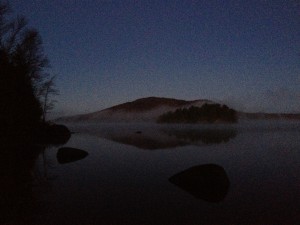
One: Looking out at the island with nesting eagles at dawn from Island House lean-to on Long Lake. Taken on October 12, 2013.
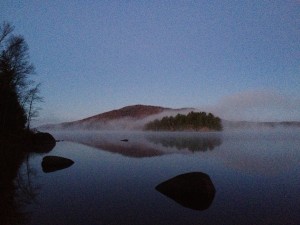
Two: Looking out at the island with nesting eagles at dawn from Island House lean-to on Long Lake. Taken on October 12, 2013.
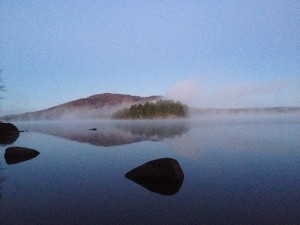
Three: Looking out at the island with nesting eagles at dawn from Island House lean-to on Long Lake. Taken on October 12, 2013.
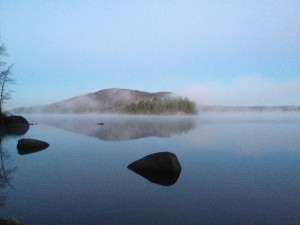
Four: Looking out at the island with nesting eagles at dawn from Island House lean-to on Long Lake. Taken on October 12, 2013.
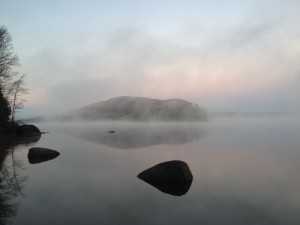
Five: Looking out at the island with nesting eagles at dawn from Island House lean-to on Long Lake. Taken on October 12, 2013.
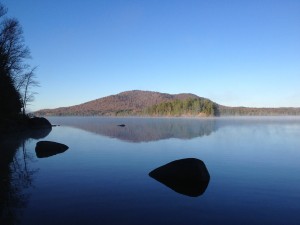
Six: Looking out at the island with nesting eagles at dawn from Island House lean-to on Long Lake. Taken on October 12, 2013.
I spotted an adult Bald Eagle perched in a dead snag on the island. I got my scope to photograph it with my iPhone attachment, but a large bank of fog rolled in and obscured the bird. Later, as we began to break down our camp, we observed two other Bald Eagles flipping and latching talons over the lake! About 10 minutes after hearing several gun shots at the north end of Long Lake (duck hunting season), I spotted a white-headed, white-tailed bird in the water with my scope. It was in the fog about ¾ of a mile away. It quickly became apparent it was an adult Bald Eagle struggling in the water. I observed it for about 15 minutes using its wings as paddles to reach the shoreline. I was sick wondering if a hunter had shot it. Even on the shore, the bird was unable to take off. I called my husband to come to the lake, and we decided to take the boat to the bird to see if it was hurt. While we discussed this, I noticed the eagle was eating – it no doubt had a very heavy fish (out of our view in all the fog) that made it impossible for the eagle to take flight! I wish I could have seen that fish!
One of the many documented effects of climate change in our area is the ice-on and ice-off dates. Historically, October was a cold month, and major snowstorms were common. Now, falls are warm, and the ice-on date has moved out nearly two months to December. Common Loons stay two months longer now, and sea planes and boats remain on the lakes into December. Snow often does not arrive to stay until January. The spring ice-off date has moved back about a month. These are rapid, unprecedented changes with frightening impacts on both flora and fauna. I reminded my husband that back in the late 1990s, October 11th would have been cold and possibly snowy. But the October of a rapidly warming world in 2013, was in the 60s on the 11th and went up to the 70s on the 12th as we boated home. “Normal” no longer seems to apply because the climate just keeps changing year to year. Tourists and summer residents still focus on July and August for visiting. Those of us fortunate enough to live here year-round have gained several months of quiet boating time on the lakes. I would gladly trade this benefit of climate change if I could turn back the clock on atmospheric CO2 to pre-industrial revolution levels…
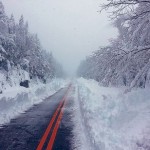
After 5 days away in northern Michigan, I arrived back home in the Adirondacks on Sunday evening of Memorial Day Weekend. I was half-listening to CNN news Monday morning, when I registered “Whiteface Mountain” and “3 FEET of snow”! I rewound the news hoping I incorrectly heard it. Five inches of rain had fallen in the lower elevations of the Adirondacks, and at higher elevations, it was snow – a great deal of snow in a short amount of time. Temperatures were in the 30s at lower elevations and as is usually the case, it was no doubt at least 10 degrees colder in the higher elevations.
I have had calls and email messages asking about Bicknell’s Thrush and how it could be faring. On May 19th I found many Bicknell’s Thrushes back, and many other species holding territories on Whiteface Mountain’s summit area. I immediately thought about the implications of such a severe weather event for all the species at high elevations. I thought about the female Bicknell’s Thrushes just returning, depleted from their long journey, arriving into a world of cold and snow. One person suggested that all the birds could simply move to lower elevations and wait out the snow melt. I highly doubt that these territorial species will leave their breeding grounds, and I suspect the event will end up taking a heavy toll on many of the birds. I recall a late April storm over a decade ago when we received a sudden two-foot snowfall. An American Woodcock ended up on someone’s porch in town (the only place it could find without snow). I called a rehabilitator friend and she immediately picked up the bird, but its weight was half of what it should have been. She tried to save the bird for 3 days, but it died. There is no doubt that many other birds died from that severe weather event. If only it was as simple as having all the birds temporarily move to a snowless place, but it just doesn’t work that way! I have observed thrushes, in particular American Robins and Hermit Thrushes, gather on plowed roadways when we’ve had late snow events. The Whiteface Mountain manager informed me that they were plowing the road and hoped to have it re-open right away. So I hope the snow-free roadway provides a place for Bicknell’s and Swainson’s Thrushes, American Robins (yes, there are actually nesting robins on Whiteface!), and other high elevation species to find food to get through this severe weather event. But only one mountain in the Adirondacks has a road, and all the other High Peaks are buried in deep snow. I have observed Bicknell’s Thrush appearing to fare well when we have received early October snowstorms before their fall migration – but not in THREE feet of snow!
A sarcastic comment was made on a recent group email message (not a birding group) about the heavy, late snowfall in the Adirondacks and how the person thought our problem was “global warming”. The ignorance in such statements is greatly troubling. While we can never prove that any one extreme weather event is the direct result of global warming, we can certainly look at the patterns and trends. Extreme weather events are becoming more frequent and more severe as we continue to add CO2 to the atmosphere at an unprecedented rate. The extreme weather graph mimics the Keeling Curve, and I might add, the world population curve also. (There were 3 billion people on the planet when I was born, and if I live to my life-expectancy, it will be 9 billion – a TRIPLING in one lifetime.) A warming planet will greatly increase the chances of extreme weather events. You would have to have your head in the sand not to notice this is already the case.
Each year, I become more worried climbing up the mountains and wondering what changes I will observe from the prior year. The rate of species expansion upslope is astounding. This year, Black-throated Green and Black-throated Blue Warblers are holding territories well over 4,000 feet on Whiteface Mountain – something that would not have been the case a decade ago. I tallied twice as many Swainson’s Thrushes during the Mountain Birdwatch survey of Whiteface Mountain in 2012 – again, something that would not have been the case a decade ago. (Scientists believe that the warming spring temperatures have allowed Swainson’s Thrushes to rapidly expand their breeding range upward in elevation – and become a potential competitor with Bicknell’s Thrush.) The steep decline in Bicknell’s Thrush numbers I’ve observed in the past couple years is particularly troubling. Observing such rapid ecological changes on the mountains over the course of a mere decade is like someone holding up a magnifying glass to climate change effects, and it is a frightening image.
Not a day goes by that I don’t think about my own unintended complicity in our warming planet, and the resulting harm done to other species, including extinction for some. In a talk that I give on climate change, I have a slide with photos depicting the typical U.S. lifestyle – two cars, 24-7 access to electricity, seemingly unlimited appliances to simplify our lives, a big (heated or cooled) home, air travel, and stores filled with a myriad of food choices, some shipped thousands of miles from around the world – all spewing CO2 into the atmosphere. I think you get the picture. We grew up with this lifestyle and no one wants to give it up. But our lifestyle is inflicting great harm on the life forms of our planet – including humans. Humans have changed the composition of the atmosphere enveloping Earth, which is a terrifying reality. As a result, the world in which our current life forms evolved is rapidly changing. Extreme weather events take a huge toll. For birds, it can hamper nesting (as 5 inches of rain and 3 feet of snow no doubt did this past weekend), and this year, bird migration was even more perilous as birds encountered extreme weather events (including changing wind patterns) when they were already depleted from such exhausting travel – resulting in a huge number of fatalities.
To leave this blog post on a more positive(!) note, I recently heard the tail-end of a piece on National Public Radio highlighting the work of a number of PhD students working on climate change. They are receiving millions of dollars for their research on artificially creating a photosynthesis process to take CO2 out of the atmosphere. It was the most hopeful news I’ve heard in a long time. There are many complications in their work, and their potential solution will take time, but it was so heartening to hear of young people concerned about climate change and working hard to find a solution. I hope they hurry.
